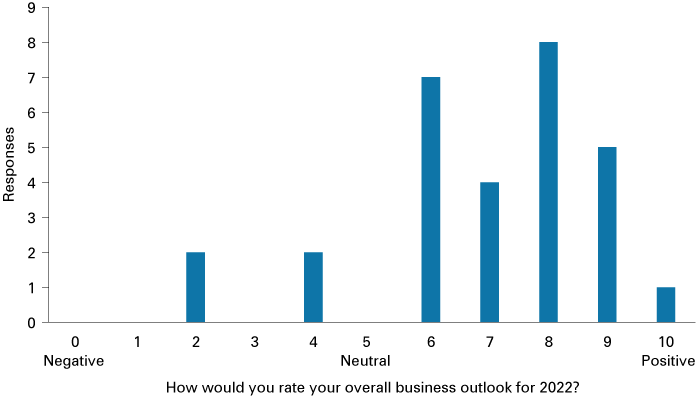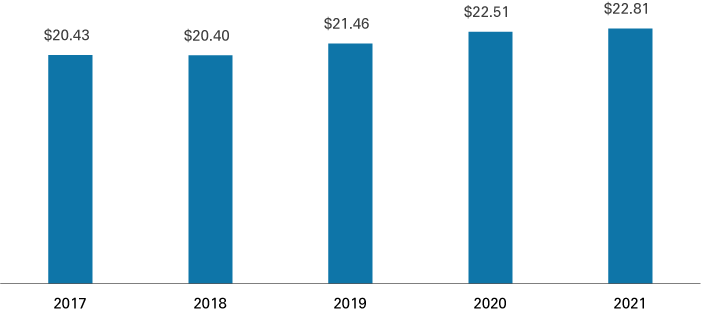Bloomington forecast 2022

President, Bloomington Economic Development Corporation

Co-director and Executive Editor, Indiana Business Research Center, Indiana University Kelley School of Business
The outlook for the Bloomington area economy in 2022 is good—a welcome respite from the economic and social roller coaster of the past two years, which has affected us in so many ways. At the end of 2020, local employers reported varying outlooks by industry, with concerns about the impact of the pandemic, remote work, Indiana University plans, labor and housing shortages, and more. While the 2022 forecast is far more positive, challenges remain.
The following local outlook is based on qualitative and quantitative data from employer surveys from the Bloomington Economic Development Corporation (BEDC) and Greater Bloomington Chamber of Commerce, as well as data from the Indiana Business Research Center (IBRC) and their Center for Econometric Modeling Research (CEMR) forecast.
Three key takeaways emerge:
- There is a positive business outlook and market forecast.
- Our market faces challenges that range from the continued pandemic to workforce and housing issues.
- There are solutions to these challenges that we can pursue together.
1. A positive outlook
Looking ahead to 2022, the Bloomington Economic Development Corporation again asked its members and partners about their own outlook for the coming year. Thirty-one mostly Bloomington-based employers responded, with 80% having fewer than 500 employees. Respondents represent industries from banking and finance, health care, construction, education, professional services, real estate, and more.
The BEDC survey asked respondents to rate their overall business outlook for 2022 on a scale of zero (negative) to 10 (positive), with an average response of 6.93 (see Figure 1). Most respondents cited customer demand for products and services and the market for their business or industry as positive contributors to their outlooks.
Figure 1: Overall business outlook for 2022 survey results

Source: Bloomington Economic Development Corporation survey
According to the CEMR forecast, the Bloomington metro economy, which is composed of Monroe and Owen counties, is back in the growth column and forecast to continue growing. The metro area has already seen a rebound in employment since the depths of 2020 and early 2021 (see Table 1).
Table 1: Bloomington metro jobs by industry trends, October 2017 to October 2021
| 2017 | 2018 | 2019 | 2020 | 2021 | 1-year change, 2020 to 2021 |
5-year change, 2017 to 2021 |
|
|---|---|---|---|---|---|---|---|
| Total nonfarm jobs | 79,700 | 80,600 | 82,100 | 76,100 | 78,000 | 2.5% | -2.1% |
| Goods-producing | 11,400 | 11,800 | 13,000 | 12,800 | 13,400 | 4.7% | 17.5% |
| Service-providing | 68,300 | 68,800 | 69,100 | 63,300 | 64,600 | 2.1% | -5.4% |
| Jobs in private industries (largest to smallest in September 2021) | |||||||
| Total private industry jobs | 52,300 | 52,900 | 54,900 | 52,300 | 53,800 | 2.9% | 2.9% |
| Private education and health services | 10,000 | 10,100 | 10,900 | 10,900 | 10,900 | 0.0% | 9.0% |
| Trade, transportation and utilities | 10,100 | 10,100 | 9,900 | 9,900 | 10,200 | 3.0% | 1.0% |
| Manufacturing | 8,600 | 9,000 | 9,700 | 9,300 | 9,700 | 4.3% | 12.8% |
| Leisure and hospitality | 9,300 | 8,900 | 8,900 | 7,300 | 7,600 | 4.1% | -18.3% |
| Professional and business services | 5,100 | 5,400 | 5,700 | 5,500 | 5,800 | 5.5% | 13.7% |
| Natural resources, mining and construction | 2,800 | 2,800 | 3,300 | 3,500 | 3,700 | 5.7% | 32.1% |
| Financial activities | 3,000 | 3,100 | 3,000 | 3,100 | 3,100 | 0.0% | 3.3% |
| Information | 1,100 | 1,100 | 1,000 | 800 | 800 | 0.0% | -27.3% |
| Other services | 2,300 | 2,400 | 2,500 | 2,000 | 2,000 | 0.0% | -13.0% |
| Jobs in government (includes public schools, public hospitals) | |||||||
| Total government jobs | 27,400 | 27,700 | 27,200 | 23,800 | 24,200 | 1.7% | -11.7% |
| Federal | 400 | 300 | 400 | 400 | 300 | -25.0% | -25.0% |
| State | 21,800 | 22,100 | 21,400 | 18,300 | 19,100 | 4.4% | -12.4% |
| Local | 5,200 | 5,300 | 5,400 | 5,100 | 4,800 | -5.9% | -7.7% |
Note: Data are for October of each year. Shaded cells indicate declines.
Source: IBRC, using U.S. Bureau of Labor Statistics Current Employment Statistics
Our forecast predicts average annual job growth of 2.3% between 2021 and 2024, which is comparable to our neighbor to the east, Columbus, but slower than that of Indianapolis, Louisville and Lafayette. Notably, personal income—the combined work earnings, dividends, rent and interest, and government transfer payments—will see significant average annual growth of 4.8% between 2021 and 2024, which is comparable to Fort Wayne, Evansville and South Bend, but slower than Indianapolis, Anderson, Columbus, Lafayette and Elkhart. As competition for workers intensifies, wages in the region continue to climb (see Figure 2), with the private industry average hourly wage increasing by 12% since October 2017.
Figure 2: Bloomington metro October average hourly wage

Source: IBRC, using U.S. Bureau of Labor Statistics Current Employment Statistics
2. Our market faces specific challenges
The BEDC survey asked respondents about factors that threaten their organizations’ health and growth in Monroe County in 2022, and the results mirror many of those found in a similar survey by the Greater Bloomington Chamber of Commerce.
In the BEDC survey, the following challenges were noted:
81% of respondents noted concerns about the COVID-19 pandemic continuing
71% mentioned workforce talent and recruitment
65% mentioned housing
65% mentioned homelessness
65% mentioned the cost of doing business
The Chamber survey asked what local factors most impact businesses and found the following:
46% of respondents noted concerns about workforce talent and recruitment
39% mentioned zoning and development
35% mentioned housing
35% mentioned homelessness
34% mentioned infrastructure
32% mentioned public safety
Some of the challenges discussed by survey respondents are reflected in workforce, housing and supply chain data.
Workforce
Between March 2020 and July 2021, the Bloomington metro’s labor force had decreased by approximately 5,000 workers. By September 2021, that number was halved as workers returned to the labor force full-time and many students returned to part-time jobs. In September, the full labor force stood at just under 79,000. Notably, the area’s labor force peaked at more than 82,000 (based on annual averages) in 2009, just after the Great Recession, according to the labor force statistics from the U.S. Bureau of Labor Statistics.
Housing
Employers continue to note that the lack of attainable housing affects their workforce. According to data from the Indiana Association of Realtors (provided by the Bloomington Board of Realtors), the median sale price of a home in Monroe County increased 15% between 2020 and 2021. As of September 2021, the median sale price was $265,000. Housing inventory is also an issue. Months supply of housing inventory is defined as the length of time necessary to sell all homes currently on the market if no new homes are listed. A healthy supply is approximately six months, but as of September 2021, the local supply was 2.3 months. Challenges with Monroe County housing prices and inventory are not exclusive to the pandemic, though existing issues were exacerbated by COVID-19.
Supply chain and costs
The manufacturing, retail, accommodation and food services, and construction industries are among those most impacted by ongoing supply chain issues. As of mid-October 2021, 43.5% of Indiana business respondents reported domestic supplier delays, according to the U.S. Census Bureau’s Small Business Pulse Survey. In the same survey, 30.2% of Indiana businesses reported a large increase in prices paid compared to what was normal prior to March 2020.
Local employers have noted the ripple effect of labor shortages and supply chain issues in their businesses. Workforce impacts production, availability and transport of goods, and product prices. Shortages for building materials, fixtures and computer chips can lead to major delays. This affects everything from food in restaurants to construction projects that require fuel, trucks and high-tech equipment.
3. There are solutions to these challenges that we can pursue together
We have a unique opportunity to influence the forecast and lay the foundation for a more resilient economy that can attract business and talent, enhance the lives of our residents, and turn striving into thriving. These are just some of the ideas already taking hold:
Minimize the spread of COVID-19: Our gratitude goes to the Monroe County Health Department, Indiana University, Indiana University Health and local officials who have been working hard to navigate a pandemic without an instruction manual. However, they cannot do it alone. There is more work to be done together as a community to minimize the spread of COVID-19 and keep our neighbors and our institutions safe.
Collaborate on shared economic development priorities: The success of an organization is not limited to the conditions in the building in which it operates. Organizations need resources and support from the community, as do their employees and patrons, to thrive in Monroe County. BEDC survey respondents noted several ways we can collaborate to provide needed resources and support:
Leadership and cooperation. Several respondents commented on the need for more effective cooperation between the City of Bloomington and Monroe County, especially in addressing prevalent challenges, such as the housing supply.
Housing development. There is land in our community that can be targeted for development of affordable, accessible housing. However, it is important to note that housing is a regional issue that cannot be solved in one location alone.
Business-friendly environment. There are ongoing opportunities to make thoughtful, consistent policies regarding zoning, permitting and processes that facilitate the growth of quality local employment.
-
Addressing homelessness. Several respondents commented that homelessness is both an individual issue—our unhoused neighbors face challenges, such as barriers to opportunity, mental health struggles or addiction—and a regional challenge. Organizations like the United Way of Monroe County and the Community Foundation of Bloomington and Monroe County are leading efforts to address these issues.
-
Workforce talent and recruitment. We have wonderful local assets, such as Indiana University, Ivy Tech and our regional workforce. We also have opportunities to connect disparate workforce interventions while addressing barriers to work, such as child care, elder care, housing, transit, training and more.
The BEDC recently announced an initiative to convene partners and community members to develop a collaborative strategy and a unified plan for rowing together, to tackle these issues across Monroe County. The goal is to create a co-owned, shared vision for the future, integrating existing efforts from across the community and region, and filling in the gaps where needed with tangible implementation steps. Stay tuned to the BEDC website for more information on how to get involved.
Overall, the local forecast and business outlook is positive, but we all can join in the work needed to ensure a resilient, sustainable and successful shared future.
About the BEDC
The Bloomington Economic Development Corporation (BEDC) is a nonprofit corporation dedicated to the retention, development and attraction of quality jobs in Monroe County.
Economic development, at its core, works to sustainably increase prosperity and quality of life for communities. It is not growth for the sake of growth. The field focuses on creating a better economic future for all by enabling individuals, companies and communities to innovate and responsibly produce and trade valuable goods and services, by maximizing talent and resources.



